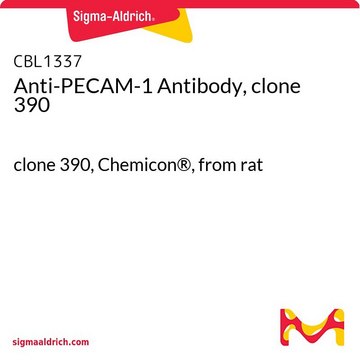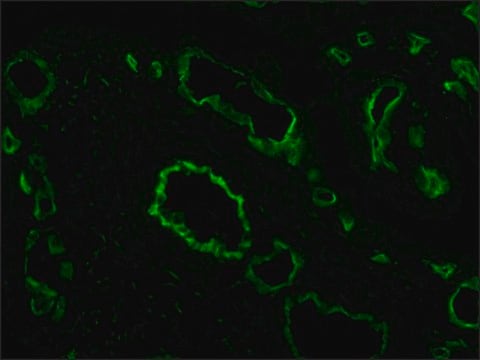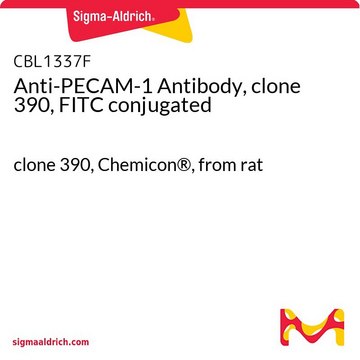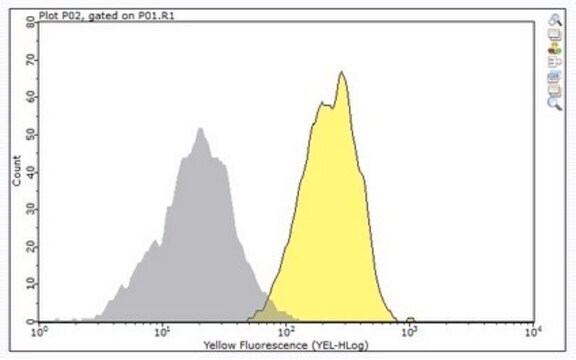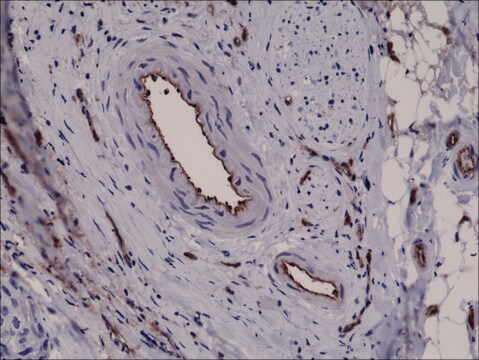おすすめの製品
由来生物
rat
品質水準
抗体製品の状態
purified immunoglobulin
抗体製品タイプ
primary antibodies
クローン
390, monoclonal
化学種の反応性
mouse
テクニック
flow cytometry: suitable
immunofluorescence: suitable
immunoprecipitation (IP): suitable
neutralization: suitable
アイソタイプ
IgG2aκ
NCBIアクセッション番号
UniProtアクセッション番号
輸送温度
ambient
ターゲットの翻訳後修飾
unmodified
遺伝子情報
mouse ... Pecam1(18613)
関連するカテゴリー
詳細
Platelet endothelial cell adhesion molecule (UniProt Q08481; also known as CD31, PECAM-1) is encoded by the Pecam1 (also known as Pecam, Pecam-1) gene (Gene ID 18613) in murine species. PECAM-1 (CD31) is a 130-kD cell adhesion molecule that is expressed at the junctions of all continuous endothelia, as well as most bone marrow-derived hematopoietic cells, including platelets, monocytes, granulocytes and some lymphocytes. The human PECAM1 and murine Pecam1 genes both produce multiple spliced isoforms with varying lengths in cytoplasmic domain, with the isoform Long being the major form expressed in human tissues and endothelial cells (ECs), and isoform delta 14-15 being the predominantly expressed murine form. PECAM-1 plays an import role in maintaining vascular integrity and function by mediating ECs interactions with pericytes and smooth muscle cells (SMCs). PECAM-1 is initially produced with a signal peptide (human a.a. 1-27, murine a.a. 1-17) sequence, the removal of which yields the mature protein with a large extracellular region (human a.a. 28-601, mouse a.a. 18-590) composed of six C2-type Ig-like domains, followed by a transmembrane seqment (human a.a. 602-620, mouse a.a. 591-609) and a cytoplasmic tail (human a.a. 621-738, mouse a.a. 610-727) that plays an essential role in PECAM-1-mediated cellular signaling.
特異性
Clone 390 immunoprecipitated the characteristic 120-130 kDa protein from L-cells transfected with muPECAM-1∆12,15 and selectively stained murine vessels in acetone-fixed tissue sections (Baldwin, H.S., et al. (1994). Development. 120(9):2539-2553).
免疫原
Epitope: extracellular domain
Mouse leukocyte cell line 32D.
アプリケーション
Research Category
細胞骨格
細胞骨格
Flow Cytometry Analysis: A representative lot detected the expression of wild-type, ∆12,15 and ∆14,15 murine PECAM-1 constructs on the surface of transfected mouse L-cells (Baldwin, H.S., et al. (1994). Development. 120(9):2539-2553).
Immunofluorescence Analysis: A representative lot localized PECAM-1 immunoreactivity by fluorescent immunohistochemistry staining of murine embryo cryosections (Baldwin, H.S., et al. (1994). Development. 120(9):2539-2553).
Immunoprecipitation Analysis: A representative lot immunoprecipitated the 120-130 kDa exogenously expressed PECAM-1 ∆12,15 construct from transfected murine L-cells (Baldwin, H.S., et al. (1994). Development. 120(9):2539-2553).
Neutralizing Analysis: A representative lot inhibited the aggregation of murine L-cell transfectants expressing wild-type and ∆12,15, but not ∆14,15, murine PECAM-1 constructs (Baldwin, H.S., et al. (1994). Development. 120(9):2539-2553).
Clone 390 is also available as FITC conjugate (Cat. No. CBL1337F) for direct immunofluorescent staining in flow cytometry, immunocytochemistry and immunohistochemistry applications.
Immunofluorescence Analysis: A representative lot localized PECAM-1 immunoreactivity by fluorescent immunohistochemistry staining of murine embryo cryosections (Baldwin, H.S., et al. (1994). Development. 120(9):2539-2553).
Immunoprecipitation Analysis: A representative lot immunoprecipitated the 120-130 kDa exogenously expressed PECAM-1 ∆12,15 construct from transfected murine L-cells (Baldwin, H.S., et al. (1994). Development. 120(9):2539-2553).
Neutralizing Analysis: A representative lot inhibited the aggregation of murine L-cell transfectants expressing wild-type and ∆12,15, but not ∆14,15, murine PECAM-1 constructs (Baldwin, H.S., et al. (1994). Development. 120(9):2539-2553).
Clone 390 is also available as FITC conjugate (Cat. No. CBL1337F) for direct immunofluorescent staining in flow cytometry, immunocytochemistry and immunohistochemistry applications.
This rat monoclonal Anti-PECAM-1 Antibody, clone 390, Cat. No. CBL1337-I is validated for use in Flow Cytometry, Immunofluorescence, Immunoprecipitation, and Neutralization applications.
品質
Evaluated by Flow Cytometry in mouse splenocytes.
Flow Cytometry Analysis: 2 µL of this antibody detected PECAM-1-positive monocytes among one million mouse splenocytes.
Flow Cytometry Analysis: 2 µL of this antibody detected PECAM-1-positive monocytes among one million mouse splenocytes.
ターゲットの説明
79.49/76.14/78.23/68.05 kDa (mature isoform 1/2/3/4), 81.26/77.92/80.00/69.82 kDa (isoform 1/2/3/4 pro-form) calculated.
関連事項
Replaces: CBL1337
物理的形状
Protein G purified.
Format: Purified
Purified rat IgG2a in PBS without azide.
保管および安定性
Stable for 1 year at -20°C from date of receipt.
Handling Recommendations: Upon receipt and prior to removing the cap, centrifuge the vial and gently mix the solution. Aliquot into microcentrifuge tubes and store at -20°C. Avoid repeated freeze/thaw cycles, which may damage IgG and affect product performance.
Handling Recommendations: Upon receipt and prior to removing the cap, centrifuge the vial and gently mix the solution. Aliquot into microcentrifuge tubes and store at -20°C. Avoid repeated freeze/thaw cycles, which may damage IgG and affect product performance.
その他情報
Concentration: Please refer to lot specific datasheet.
免責事項
Unless otherwise stated in our catalog or other company documentation accompanying the product(s), our products are intended for research use only and are not to be used for any other purpose, which includes but is not limited to, unauthorized commercial uses, in vitro diagnostic uses, ex vivo or in vivo therapeutic uses or any type of consumption or application to humans or animals.
適切な製品が見つかりませんか。
製品選択ツール.をお試しください
保管分類コード
12 - Non Combustible Liquids
WGK
WGK 2
引火点(°F)
Not applicable
引火点(℃)
Not applicable
適用法令
試験研究用途を考慮した関連法令を主に挙げております。化学物質以外については、一部の情報のみ提供しています。 製品を安全かつ合法的に使用することは、使用者の義務です。最新情報により修正される場合があります。WEBの反映には時間を要することがあるため、適宜SDSをご参照ください。
Jan Code
CBL1337-I:
試験成績書(COA)
製品のロット番号・バッチ番号を入力して、試験成績書(COA) を検索できます。ロット番号・バッチ番号は、製品ラベルに「Lot」または「Batch」に続いて記載されています。
Rose Z Hill et al.
Nature, 607(7917), 104-110 (2022-06-23)
Itch triggers scratching, a behavioural defence mechanism that aids in the removal of harmful irritants and parasites1. Chemical itch is triggered by many endogenous and exogenous cues, such as pro-inflammatory histamine, which is released during an allergic reaction1. Mechanical itch
ライフサイエンス、有機合成、材料科学、クロマトグラフィー、分析など、あらゆる分野の研究に経験のあるメンバーがおります。.
製品に関するお問い合わせはこちら(テクニカルサービス)